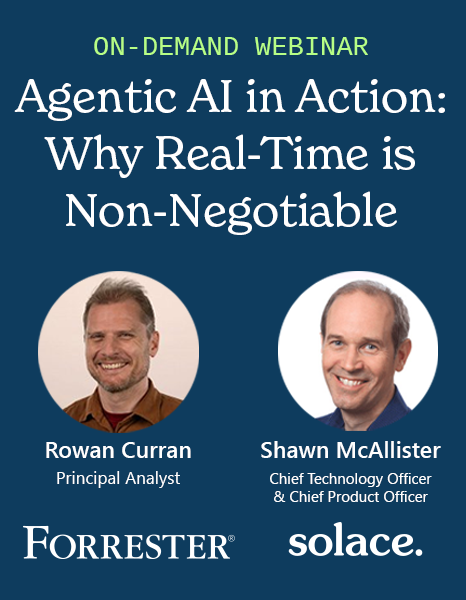Home > Blog > Artificial Intelligence
Subscribe to Our Blog
Get the latest trends, solutions, and insights into the event-driven future every week.
Thanks for subscribing.
The future of artificial intelligence lies not in human-supervised systems operating within predefined constraints, but in increasingly agile agents responding to changing environments and emerging challenges. Solace provides the architectural foundation that enables that evolution, while Kafka’s limitations mean increasing confinement.
Many current approaches to event-driven multi-agent systems, such as those outlined in Sean Falconer’s distributed state framework, focus on coarse-grained interaction patterns. This model works within Kafka’s limitations but obscures future challenges as your architecture evolves.
This dual requirement—orchestrated intelligence gathering plus micro-targeted distribution to both AI agents and non-AI systems—represents where Kafka’s rigid architecture becomes a fundamental barrier to AI evolution. That’s why mission-critical AI systems—whether military, financial, healthcare, or industrial—demand capabilities that go far beyond what traditional messaging platforms like Kafka can deliver.
This became particularly evident when a government contractor approached Solace about creating a cutting-edge approach to military situational awareness, leveraging event-driven architecture (EDA), resilient transport mechanisms, and agentic AI to deliver actionable intelligence when it matters most. The solution synthesizes multiple sources of intelligence, many from front line locations, into a single piece of actionable intelligence that can be widely distributed.
To see the full solution, check out this video:

The Dual-Pattern Architecture Challenge
Mission-critical AI systems require two fundamentally different capabilities that most event platforms struggle to support simultaneously.
Orchestrated Intelligence Gathering
Multi-agent coordination where a cloud-based AI orchestrator must collect responses from multiple specialized AI agents processing edge data streams, correlate their findings, and synthesize coherent decisions. This requires sophisticated asynchronous coordination with response aggregation logic.
Solace provides this capability through an orchestration framework we call Agent Mesh. For our government contractor, Agent Mesh queries five specialized cloud agents about sensor data from the base, it needs guaranteed delivery to each agent, the ability to correlate responses back to the original edge data, and timeout logic to proceed even if some agents are unresponsive.
Instantaneous, Targeted Distribution
Infrastructure-level instant notification where a single event triggers immediate, simultaneous distribution to dozens or hundreds of endpoints without waiting for acknowledgments. When the threat assessment completes, the system must instantly notify specific tactical displays, automated defense systems, exact mobile units, precise edge-deployed AI agents, IoT sensors, and backup systems—all simultaneously and asynchronously with sub-millisecond latency.
Mission-critical AI systems need both patterns operating simultaneously within the same infrastructure—and this dual requirement exposes fundamental limitations in Kafka’s architecture while highlighting Solace’s purpose-built advantages.
Why Kafka’s Rigidity Cripples Agile AI
Even when paired with an collaborative agent framework, Kafka’s architectural limitations soon become insurmountable barriers with AI agents.
- Topic Proliferation Nightmare: Kafka’s flat topic structure leads to exponential sprawl as agents form new coordination patterns. A single cross-regional threat correlation might require dozens of manually created topics (e.g., threat_correlation_north_america_europe). As AI scales, topic management becomes a human bottleneck.
- Subscription Rigidity: Kafka mandates hardcoded topic subscriptions, limiting adaptability. If an agent needs logistics data tied to new insurgent activity, it can’t dynamically receive it—humans must reconfigure and redeploy code, often taking hours or days and missing the moment.
- Protocol Imprisonment: Kafka’s single-protocol model traps agents needing flexibility. In constrained environments where lightweight protocols like MQTT are ideal, agents are forced to use Kafka’s default—limiting interoperability and performance.
Solace Smart Topics: Purpose-Built for AI Evolution
In contrast to Kafka, Solace’s intelligent routing architecture directly enables the adaptation capabilities that AI systems require, while Kafka’s rigidity hinders true evolution.
- Hierarchical Intelligence: Solace’s topic hierarchy naturally supports dynamic subscription routing based on agent discoveries. As agents discover new correlation patterns, the infrastructure can dynamically expand information routing using wildcard patterns that automatically capture relevant data streams. Topics like threat/vector/*/correlation/* enable the system to route new threat correlation patterns to appropriate agents as they emerge.
- Agent Mesh Orchestrator for Agile Coordination: Solace Agent Mesh’s Orchestrator provides the sophisticated coordination infrastructure that agile agents need to self-organize and adapt. The orchestrator enables agents to agilely discover new agent types through service discovery, dynamically forming coordination relationships based on capability matching. When the Orchestrator identifies a complex multi-vector threat, it can agilely recruit additional specialized agents.
- Dynamic Protocol Adaptation: Solace’s multi-protocol support means agents can use the protocol that makes sense based on operational context. An agent operating in a bandwidth-constrained environment can utilize AMQP for guaranteed delivery, MQTT for lightweight communication, or WebSocket for real-time coordination—all while maintaining the same topic subscriptions and coordination relationships.
Your Agents Everywhere: At the Edge, On-Premises or in the Cloud
- Solace Event Mesh: Solace brokers discover and integrate with existing infrastructure no matter if it’s in the cloud, on-premises or in the middle of a field. Edge intelligence operates agilely even during network disruptions, automatically synchronizing with cloud resources when connectivity resumes.
- Kafka Dependency on Human Configuration: Kafka edge deployment requires manual configuration and ongoing human management. Network disruptions require human intervention to resolve coordination issues. New cloud-based AI capabilities cannot be agilely discovered by edge systems. Protocol adaptation requires manual reconfiguration and system restarts. Edge intelligence remains dependent on human operators for adaptation and optimization.
Agile Adaptation vs Rigid Configuration
The fundamental difference between Solace and Kafka becomes clear when comparing their support for agile AI evolution versus static human-configured systems.
- Solace Enables Agile Evolution: The Agent Mesh uses the Orchestrator to discover and coordinate with new agent types as they’re deployed. So should military operations introduce a new Cyber Threat Analysis Agent, existing agents automatically discover its capabilities through service registry, establish appropriate coordination channels, and begin incorporating cyber intelligence into their threat assessments without human configuration changes. The orchestrator provides agile service discovery, intelligent load balancing across dynamically discovered agent instances, and self-healing coordination patterns that adapt to changing agent availability.
- Kafka Forces Human Intervention: Instead of agile agent evolution, Kafka requires Kafka configuration: new agent types need manually created topics, existing agents require subscription updates and code deployment, coordination patterns must be hardcoded by engineers, and service discovery requires custom application-layer implementation. When agents discover new collaboration patterns, human operators must intervene to create appropriate topic structures and update subscription logic—violating the autonomy principle.
Conclusion: The Agile Imperative in AI
The evolution toward agile AI systems represents more than just technological advancement, it’s a fundamental shift. This transformation demands event architectures that can support adaptation, diverse interactions patterns, and self-optimizing communication behaviors.
Kafka’s rigid architecture, static topic structures, and single-protocol limitations create insurmountable barriers to agile AI evolution. Every aspect of intelligent adaptation requires human intervention—from creating new topics to updating subscription patterns to integrating new agent types.
For organizations deploying AI systems, the choice between enabling agile AI and constraining AI within rigid configurations is a strategic decision that will determine their competitive advantage. In the age of agile AI, that choice is definitely Solace.
Agentic AI in Action:Why Real-Time Is Non-NegotiableOn-demand webinar featuring agentic AI case studies and expert analysis from Forrester.Watch the Webinar

Explore other posts from category: Artificial Intelligence

As an architect in Solace’s Office of the CTO, Jesse helps organizations of all kinds design integration systems that take advantage of event-driven architecture and microservices to deliver amazing performance, robustness, and scalability. Prior to his tenure with Solace, Jesse was an independent consultant who helped companies design application infrastructure and middleware systems around IBM products like MQ, WebSphere, DataPower Gateway, Application Connect Enterprise and Transformation Extender.
Jesse holds a BA from Hope College and a masters from the University of Michigan, and has achieved certification with both Boomi and Mulesoft technologies. When he’s not designing the fastest, most robust, most scalable enterprise computing systems in the world, Jesse enjoys playing hockey, skiing and swimming.


Subscribe to Our Blog
Get the latest trends, solutions, and insights into the event-driven future every week.
Thanks for subscribing.
